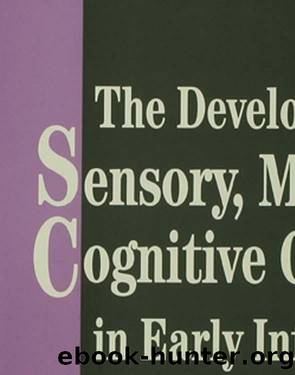The Development of Sensory, Motor and Cognitive Capacities in Early Infancy: From Perception to Cognition by Francesca Simion & George Butterworth

Author:Francesca Simion & George Butterworth
Language: eng
Format: epub
Publisher: Psychology Press
COMPREHENSION OF POINTING IN BABIES
As is the case for studies of language, researchers have distinguished between processes involved in the comprehension and production of manual pointing. Many studies agree that the comprehension of pointing, at about 10 months, slightly precedes its production (Butterworth & Grover, 1989; Franco & Butterworth, 1996; Leung & Rheingold, 1981; Messer, 1994). There is also evidence that the spatial conditions of testing influence whether infant’s comprehend pointing or not. An early study by Lempers (1976) for example, found that babies of 9 months comprehend pointing to nearby targets and by 12 months they comprehend pointing to more distant targets (when the targets are on the same side of the room as the pointing hand). Morissette, Ricard and Gouin-Decarie (1995) in a longitudinal study also found that comprehension of manual pointing to relatively distant targets begins at about 12 months. They found that the angle subtended by the targets, relative to the baby, influenced the probability of comprehension. Targets at 20 degrees from the midline and 0.85 metres distance were localised at 12 months, before targets at 70 degrees and 2.11 metres which were localised at 15 months. Again, the most frequent error of babies was to look at the pointing hand rather than at the designated target. Perhaps related is the finding, by Murphy and Messer (1977), that pointing comprehension was earlier (9 months) for targets on the same side of the room as the pointing hand than when the point was into the contralateral half of the infant’s visual space, across the body midline of the adult (12 months).
Butterworth and Grover (1988, 1989) showed that pointing was understood by 12 months. By contrast, infants at 6 or 9 months were as likely to fixate the pointing hand as the designated target. If babies at 6 and 9 months succeeded in fixating the target, they did so in a two-step manner, pausing first at the adult’s hand, then alighting on the target, whereas 12-month-babies looked to the target rapidly and smoothly. Indeed, it has sometimes been noted that mothers go to a great deal of trouble, with exaggerated hand movements, to lead the young infant’s gaze from her hand onto the target (Murphy & Messer, 1977). This may be a component in learning to interpret the manual pointing signal between the ages of 9 and 12 months. Grover (1988) showed that the infant’s latency to fixate the correct target significantly decreases between 9 and 12 months. She also showed that manual pointing is a more potent signal than a simple change in head and eye orientation. Babies at 12 months were significantly more likely to respond when the signal included a point and more likely to fixate a target further into the periphery of vision, even if this meant ignoring an identical target seen earlier along the scan path.
Ecological factors also influence the form and incidence of the infant’s response to pointing. The likelihood of a response to pointing increased from 69% to 80% of trials when the number of targets in the field of view was increased from one to two.
Download
This site does not store any files on its server. We only index and link to content provided by other sites. Please contact the content providers to delete copyright contents if any and email us, we'll remove relevant links or contents immediately.
Should I Stay or Should I Go? by Ramani Durvasula(7510)
Why We Sleep: Unlocking the Power of Sleep and Dreams by Matthew Walker(6540)
Fear by Osho(4613)
Flow by Mihaly Csikszentmihalyi(4570)
Rising Strong by Brene Brown(4332)
Why We Sleep by Matthew Walker(4306)
The Hacking of the American Mind by Robert H. Lustig(4257)
How to Change Your Mind by Michael Pollan(4247)
Too Much and Not the Mood by Durga Chew-Bose(4219)
Lost Connections by Johann Hari(3986)
He's Just Not That Into You by Greg Behrendt & Liz Tuccillo(3797)
Evolve Your Brain by Joe Dispenza(3560)
The Courage to Be Disliked by Ichiro Kishimi & Fumitake Koga(3343)
Crazy Is My Superpower by A.J. Mendez Brooks(3263)
Resisting Happiness by Matthew Kelly(3260)
In Cold Blood by Truman Capote(3257)
What If This Were Enough? by Heather Havrilesky(3241)
The Book of Human Emotions by Tiffany Watt Smith(3190)
Descartes' Error by Antonio Damasio(3183)
